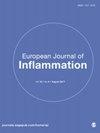糖尿病临床感染/炎症的护理点检测
IF 0.6
4区 医学
Q4 IMMUNOLOGY
引用次数: 0
摘要
引言:糖尿病患者容易感染。C反应蛋白(CRP)水平升高表示潜在的感染/炎症;因此,独立于葡萄糖水平的可靠的护理点(POC)CRP测量将有利于快速检测炎症过程并允许及时进行适当的治疗。方法:对诊断为感染性或非感染性炎症的2型糖尿病患者进行验证研究,在用于测量毛细血管葡萄糖水平的同一滴血上进行毛细血管CRP测量。结果:154份来自糖尿病患者的样本,在广泛的CRP水平范围内进行了毛细管CRP测量,与广泛的CRP测定相比,动态范围呈线性,R2=0.9具有显著相关性,斜率为0.98(95%C.I:0.91-1)。Bland-Altman分析显示出正偏差;测定之间的总差异为6.6mg/L。方法之间的平均偏差为13.34%(C.I 95%9.8–17.5%)。两种方法之间的总一致性为89%,观察到的Kappa指数为:0.71,置信区间为0.57–0.84,表明两种方法基本一致。C反应蛋白水平与葡萄糖浓度无关。结论:护理点毛细管CRP检测是早期检测糖尿病患者感染/炎症的有用手段,使治疗医生能够快速评估和治疗患者潜在的炎症过程。本文章由计算机程序翻译,如有差异,请以英文原文为准。
Point of care detection of infection/inflammation in the diabetic clinic
Introduction: Patients with diabetes are prone to infections. An elevated C-reactive protein (CRP) level indicates an underlying infection/inflammation; hence, a reliable point-of-care (POC) CRP measurement, independent of glucose level, would be advantageous in rapid detection of an inflammatory process and allowing for appropriate therapy in a timely manner. Methods: A validation study of patients with type 2 diabetes mellitus diagnosed with an inflammatory condition either infectious or non-infectious underwent a capillary CRP measurement on the same blood drop used for the measurement of capillary glucose level. Results: 154 samples from patients with diabetes across a broad range of CRP levels that underwent capillary CRP measurement, demonstrating a linear profile of the dynamic range compared with the wide range CRP assay, with significant correlation of R2 = 0.9 and a slope of 0.98 (95% C.I: 0.91–1). Bland Altman analysis, presents a positive bias profile; the total difference between assays is 6.6 mg/L. The mean bias between methods is 13.34% (C.I 95% 9.8–17.5%). The total agreement between the methods is 89%, the observed Kappa index is: 0.71 with confidence interval of 0.57–0.84 indicating substantial agreement between the methods. C-reactive protein level is independent of glucose concentration. Conclusion: Point-of-care capillary CRP testing is a useful mean of early detection of infection/inflammation in patients with diabetes and enables the treating physician to rapidly assess and treat the patients underlying inflammatory process.
求助全文
通过发布文献求助,成功后即可免费获取论文全文。
去求助
来源期刊
CiteScore
0.90
自引率
0.00%
发文量
54
审稿时长
15 weeks
期刊介绍:
European Journal of Inflammation is a multidisciplinary, peer-reviewed, open access journal covering a wide range of topics in inflammation, including immunology, pathology, pharmacology and related general experimental and clinical research.

 求助内容:
求助内容: 应助结果提醒方式:
应助结果提醒方式:


